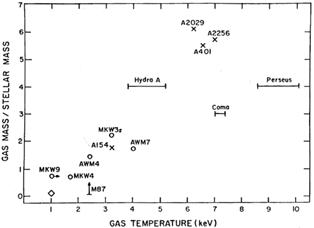


The discussion above has illustrated the importance of X-ray observations of the intracluster medium for understanding the overall properties of clusters. In addition to providing information on the structure and morphology of clusters, the amounts of accreting material, and the total mass distribution, the intracluster medium is important in its own right. The ICM is a major baryonic component of the cluster being equal or greater in mass than the stellar matter. It is, thus, of particular importance to determine the origin of such a large fraction of the known baryonic mass of the cluster.
Two opposing models for the origin of the ICM are those that suggest the gas is either primordial or that it has been ejected from galaxies. The primordial origin of the ICM assumes that the gas has not undergone nucleosynthesis in stellar systems but has fallen into the gravitational potential of the cluster (e.g., Gunn and Gott 1972). Alternatively, galaxy formation could have been 100% efficient and the observed ICM would then have been ejected or stripped from galaxies comprising the cluster. As discussed below, a combination of the two processes is most likely. The large fraction of the luminous baryonic matter in the ICM implies a primordial component of the ICM (in most standard scenarios) and the abundances of heavy elements (25% to 50% of the solar value) in the ICM require injection of enriched material that has undergone nucleosynthesis in stellar systems.
To begin to address the questions of the origin of the ICM and the efficiency of galaxy formation in different environments, it is useful to compare the ratio of gas mass to stellar mass in a variety of systems ranging from groups of galaxies to rich clusters. It is well known that the mass-to-light ratio increases with the size of the system (e.g., Blumenthal et al. 1984). However, from poor to rich clusters the fraction of X-ray emitting gas to virial mass remains relatively constant (~ 10% within the central five core radii; Abramopoulos and Ku 1983). Therefore, the ratio of gas mass to stellar mass should increase from the poor to rich clusters. As shown in Figure 8, in groups of galaxies the gas mass is approximately equal to the stellar mass, while in very rich clusters, the gas mass exceeds the stellar mass by as much as a factor of six.

|
Figure 8. The ratio of the gas mass as measured by the X-ray observations to the stellar mass is plotted against the temperature of the gas. The gas and stellar masses are evaluated within five core radii. The temperature of the gas reflects the gravitational potential of the system. The increasing ratio of gas mass to stellar mass with increasing gas temperature suggests a decreasing efficiency of galaxy formation (conversion of gas to luminous stellar matter) between groups and rich clusters (see David et al. 1989a for details). |
The observational material needed to add additional data points to Figure 8 is only just becoming available and more data are needed to confirm the relation. Oemler (private communication) has obtained a similar result for a different set of clusters by comparing optical luminosity and X-ray gas mass. He found that the dependence of gas mass on optical luminosity could be described by a power law with an exponent considerably in excess of unity.
The discovery of heavy elements in the ICM (Mitchell et al. 1976 and Serlemitsos et al. 1977) revealed an entirely new aspect to the study of the ICM - one which is crucial in determining its origin. Since heavy elements can be produced only through thermonuclear reactions in stars or by supernovae, the discovery that the intracluster medium was enriched in iron required that material processed through stars be ejected into the ICM. The near solar abundance of the ICM measured by early X-ray experiments (see Mushotzky 1984 for an early summary and Edge 1989 for a recent compilation) led to the suggestion that a large fraction of the material in the ICM was ejected from galaxies (e.g., DeYoung 1978).
While the enriched material must come from the galaxies (in the absence of a Population III stellar component), more recent studies suggest that the bulk of the ICM of a rich cluster could not have originated within the galaxies because its mass is several times larger than the mass of the galactic stellar component. Thus, the bulk of the ICM in rich clusters must be "left over" from the formation of the galaxies. In particular, numerical modeling of the hot gaseous coronae around elliptical galaxies shows that over a Hubble time these galaxies can contribute only a fraction of their stellar mass to the IGM (David, Forman, and Jones, 1989b).
While such an analysis constrains the contribution from present epoch galaxies to the ICM, we can use the ratios of the stellar mass to gas mass in groups and clusters to limit both the mass lost to the ICM from present epoch galaxies as well as any contribution from early, Population III stars. Specifically, so long as the IMF's and the Population III component of groups and clusters are similar and no gas is lost from the system, then we would expect the stellar contribution to the ICM per unit stellar mass to be the same in all groups and clusters. The approximate equality of gas mass and stellar mass in the low X-ray luminosity Morgan groups (MKW4, MKW9, and AWM4) limits the contribution to the ICM by all stars to no more than the present stellar mass. Thus, in the richest clusters where the gas mass is three to six times the stellar mass, only a small fraction of the ICM could have been produced in stars. In the rich clusters, most of the gas in the intracluster medium must be primordial.